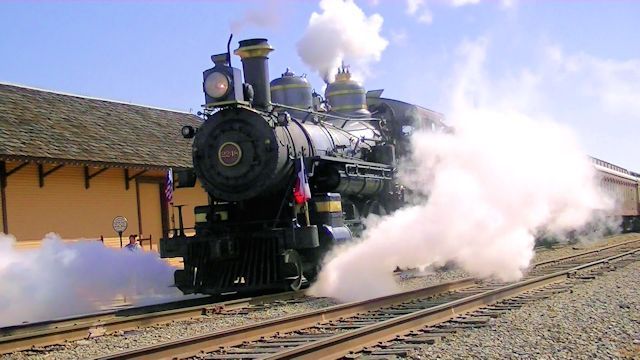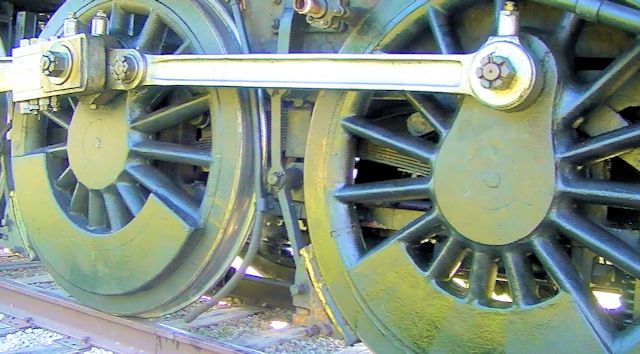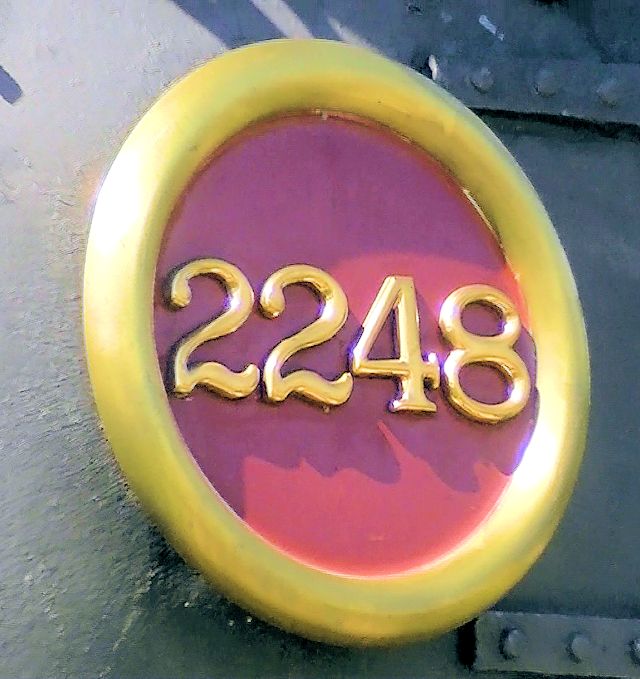To a scientist, it’s just a self-propelled water heater. But to a romantic, it’s a cast-iron time machine that carries passengers back to the past.
If you want to see, hear, and even smell what life in Fort Worth was like during the sixty years or so when the city was a billowing, bellowing railroad center during the age of steam, go out to the Stockyards or up to Grapevine on the first Saturday of the month from March through November.
 That’s when Puffy the steam engine (Puffy also answers to “engine 2248” and the “William S. Davis”) pulls the Grapevine Vintage Railroad tourist train twenty-one miles between Grapevine and the Stockyards on the old St. Louis-Southwestern (Cotton Belt) track.
That’s when Puffy the steam engine (Puffy also answers to “engine 2248” and the “William S. Davis”) pulls the Grapevine Vintage Railroad tourist train twenty-one miles between Grapevine and the Stockyards on the old St. Louis-Southwestern (Cotton Belt) track.
To behold engine 2248 is to behold a living thing, an iron dinosaur. It breathes through its smokestack. It sighs through its steam valves. It sprays sand (for traction) from its sand tubes. It moves by articulating a complicated skeleton of rods, pistons, and wheels just as we do bones and muscles and tendons. It is as dependent on its bodily fluids (water, lubricating oil, fuel oil) as we are on blood.
Puffy moves to the rhythms of the age of steam, the age of moving parts. Listen to the engine breathe (chuff . . . chuff . . . chuff). Listen to the clacking of the wheels over the points of the rails. Watch as a rail flexes as each set of wheels—of engine or coach—passes over it, first sagging as the wheels press down with their heavy burden, then rising as the wheels roll off.

A video clip of engine 2248 (below) shows that there is nothing subtle about a steam locomotive. It gulps enough water to make a teetotaler smile. Its machinery is complicated enough to make Rube Goldberg smile. Its firebox is hot enough to make Beelzebub smile. It belches smoke and hisses steam like a volcano. It envelopes all who stand near it in clouds of steam that quickly cool and condense into mist. Its steam whistle shrieks; its brass bell clangs.
Now multiply those sounds by, oh, a few dozen to get an idea of what Fort Worth sounded like at any given time a century ago.
In 1873 civic booster and newspaper editor B. B. Paddock had drawn his “tarantula map,” predicting that Fort Worth eventually would have as many railroad lines as a spider has legs. (At the time of his prediction Fort Worth had exactly zero railroads.)

But the first railroad did arrive—in 1876—quickly followed by others, and in 1903 the Telegram said Fort Worth had seventy-eight passenger trains a day—the most of any city in Texas. And in 1913 The Book of Fort Worth said the city had as many freight trains as passenger trains.
 By 1921, sure enough, Fort Worth had ten passenger railroads, enough to outfit Paddock’s tarantula and have two legs as spares. That year Fort Worth had eighty-eight passenger trains arriving or departing each day. And that does not include freight trains.
By 1921, sure enough, Fort Worth had ten passenger railroads, enough to outfit Paddock’s tarantula and have two legs as spares. That year Fort Worth had eighty-eight passenger trains arriving or departing each day. And that does not include freight trains.
And remember that Fort Worth was much smaller back then (population 106,000 in 1920). Heck, all those passenger trains came and went from just two stations located only four blocks apart downtown!
Imagine the noise, the smoke, the smell as locomotives bellowed and billowed, burning coal and heating up the oil that kept their tight-toleranace parts lubricated.
All of those eighty-eight trains a day were pulled by steam locomotives like engine 2248, if not even larger than 2248. Engine 2248 is a 4-6-0 type (four leading wheels, six driving wheels, no trailing wheels) locomotive, built in 1896 at the Cooke Locomotive Works in Paterson, New Jersey. The Southern Pacific Railroad used engine 2248 in California for passenger and freight service for decades before a private collector bought the engine.
 Engine 2248 during World War I. (Family photos from David Rawson.)
Engine 2248 during World War I. (Family photos from David Rawson.)
The Texas State Railroad bought engine 2248 in 1974. In 1990 Fort Worth & Western Railroad bought engine 2248 and spent $1 million over two years to restore it. In 1992 engine 2248 began operating on FWWR’s Tarantula tourist train, which ran between FWWR’s 8th Avenue railyard and the Stockyards. The train also occasionally ran to Granbury.
Then FWWR acquired the old Cotton Belt track and extended the Tarantula route to the old Cotton Belt depot in Grapevine in 1996. In 2004 the city of Grapevine took over operation of the Tarantula railroad as the “Grapevine Vintage Railroad.”
Ecological trivia: Engine 2248 has been retrofitted to burn recycled motor oil.
Genealogical trivia: Engine 2248 is named for William S. Davis, a founder of Fort Worth & Western Railroad and brother of Cullen Davis.
Watch—and listen—as engine 2248 backs from a siding to the Grapevine depot and then departs for the Stockyards:
Engine 2248 travels from today to yesterday and from Grapevine to the Stockyards, passing under I-35 and Long Avenue and crossing Northeast 23rd Street beside the Swift packing plant:
Train Time! Maybe 11:23 a.m., July 19, 1876 Looked a Bit Like This:
“May I Have This Dance?”: Engine 2248 on the Turntable:
Still dream of steam? Watch two video clips of Union Pacific engine 844’s visit to Fort Worth: Pumping Iron: The Past Makes a Whistle Stop.
Posts About Trains and Trolleys






Nice article and website! I got to talk with you some on the bridge during their run in May. Just thought I’d let you know that they are running her every Saturday through November now.
Thanks, Jadon. I had so much fun shooting that train. I kept cranking out videos. Thanks for the tip! Those once-a-month runs don’t come around very often.
Great video. I need to get off my butt and go ride Puffy. I was a passenger in a car travelling on Main St. Grapevine recently (maybe for only the 2nd time). Looks like there is a lot to keep you busy for several weekends.
Thanks, Ramiro. Two more to come. Funny: I never think about riding that train, just watching it go by. Same with the Texas State Railroad. Now if I could ride in the cab, that would be different . . .